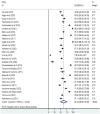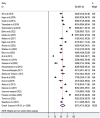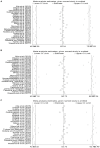Knowledge, attitudes and prevention practices related to dog-mediated rabies in Ethiopia: a systematic review and meta-analysis of observational epidemiological studies from inception to 2023
- PMID: 38179558
- PMCID: PMC10764596
- DOI: 10.3389/fpubh.2023.1276859
Knowledge, attitudes and prevention practices related to dog-mediated rabies in Ethiopia: a systematic review and meta-analysis of observational epidemiological studies from inception to 2023
Abstract
Background: Rabies is a horrific and neglected zoonotic disease that kills thousands of people worldwide each year and continues to pose threats to public health. Prevention and control of dog-transmitted rabies require mapping the level of understanding, perception, and existing practices to minimize its impacts on health. Therefore, we undertook this systematic review and meta-analysis to pool evidence from available data on knowledge, attitudes, and prevention practices regarding the disease from studies conducted in various areas of Ethiopia.
Methods: Articles were searched in electronic bibliographic medical databases such as the Excerpta Medica database, PubMed, Web of Science, African Journals Online, Google Scholar, and Scopus. We used Microsoft Excel spreadsheets and STATA software version 16 for the data excerption and analysis, respectively. The variability among studies was evaluated via Higgins and Thompson's I2 statistics and the x2 test (significant at p ≤ 0.1). The Dersimonian and Laird random-effect meta-analysis model was used to estimate the pooled effect at a 95% uncertainty interval (UI). Visual inspection and Egger's test (significant at p ≤ 0.05) were used to identify the presence of small-study effects.
Results: The search identified 1,249 electronic records. Of them, 27 studies involving 11,150 participants met the inclusion criteria. The pooled prevalence of a good level of knowledge was 62.24% (95% UI: 48.56, 75.92). Furthermore, the pooled prevalence of a favorable level of attitudes towards rabies and a good level of rabies prevention practices was only 56.73% (95% UI: 47.16, 66.29) and 52.73% (95% UI: 43.32, 62.15), respectively.
Conclusion: The study revealed credible gaps in attitudes and prevention practices, though some level of knowledge about dog-mediated rabies was demonstrated. Therefore, we call for country-wide cross-sectoral collaboration to allow for the realization of a global elimination strategy for dog-mediated human rabies.
Keywords: Ethiopia; attitudes; knowledge; practices; rabies; systematic review.
Copyright © 2023 Woldegeorgis, Genebo, Gebrekidan, Kassie, Azeze and Asgedom.
Conflict of interest statement
The authors declare that the research was conducted in the absence of any commercial or financial relationships that could be construed as a potential conflict of interest.
Figures






References
-
- Fooks AR, Jackson AC. Rabies: scientific basis of the disease and its management. Cambridge, MA: Academic Press; (2020).
-
- World Health Organization . WHO expert consultation on rabies: third report, vol. 1012. Geneva: World Health Organization; (2018).
-
- Mesfin Z. A retrospective study of suspected human rabies exposure cases in Addis Ababa, Ethiopia. Am J Public Health Res. (2022) 10:44–50. doi: 10.11648/j.ajhr.20221003.11 - DOI
Publication types
MeSH terms
LinkOut - more resources
Full Text Sources
Medical
Miscellaneous

